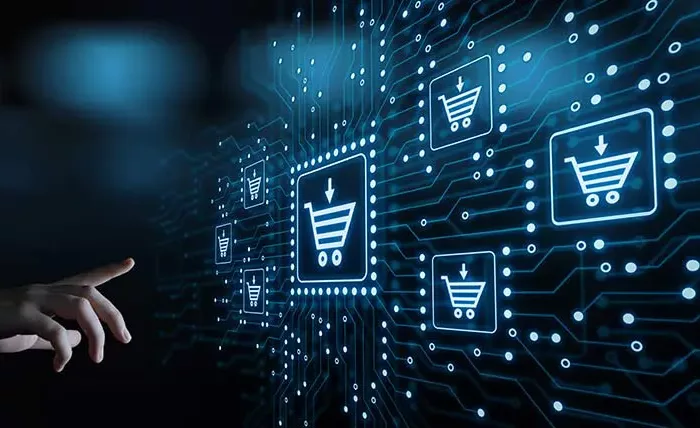Share
Author
George Anderson
Share
Mobile app, or mobile-friendly ecommerce?
How do you reach the growing mobile device segment in ecommerce? As real data suggests, mobile usage in B2B ecommerce is skyrocketing. Manufacturers understand that mobile is a critical piece of the digital commerce puzzle.
But how do you address that piece? Do you build one mobile-responsive ecommerce store, or do you build a mobile app (or two—see below) to run in parallel with your desktop ecommerce store?
This is a huge question. How you answer it will either save you time, money, and headaches, or cost you in all three.
As you’re formulating an answer to that question, here are 7 things you need to know about mobile apps in B2B. Let’s dive in.
1. Just building an app? Not exactly.
First of all, you can’t just “build an app.” You need to build two apps—one for iOs, one for Android. That’s two separate development projects (and budgets).
There’s one exception to this rule. If you build in a cross-platform language like React Native, you can build just one app. But an app built this way isn’t in the $50k range, in fact, the median cost to build an enterprise app is over $170,000 with some surveys finding the average closer to $270,000.
2. App adoption doesn’t even come close to mobile web adoption
Here’s the second thing to consider. In the early 2010s, yes, apps were supposed to be the next big thing. They were supposed to take over the web. But as Venture Beat reports, that never materialized.
In fact, the article goes on to explain how 8 out of 10 minutes a user spends on their phone are dedicated to their 3 favorite apps. While we all fantasize about our app breaking into that top 3, we have be realistic. Is a B2B app ever going to beat out personalized consumer apps like Facebook, Twitter, and music players in that top 3 slot?
3. Apps can’t give you a public catalog, which you need for findability
Let’s talk about findability for a moment. If you want your products to be discoverable (which exposes you to potential new business), you need a public-facing product catalog. Since an app is based on download and, in the case of B2B, will require a login, that’s simply impossible. You can’t offer a public catalog in a mobile app.
What does this mean for casual users and new users? It means you can’t even start making an impression on them until they’ve downloaded your app. But why would they download it? They don’t yet know what kind of products you offer, so they have no strong incentive to learn more.
4. Apps simply don’t last
I hate to say this, because I know how expensive they are. But apps and their adoption simply don’t last. On average, an app lasts a few months on a user’s phone before it’s deleted.
According to Android Authority, 77% of users stop using a mobile app within 3 days of installing it.
Three. Days.
What’s more, the article reports, 90% of users are gone after 1 month, and 95% are gone after three months.
Let me tell you—your B2B app is going to be deleted.
5. Mobile sites DO last
In contrast, mobile sites are hardly ever abandoned for good. Why? Because the web is still the standard for B2B ecommerce. What’s more, a mobile-friendly B2B ecommerce website also works on desktop—and most B2B buyers interact with your company at work. While some will conduct ecommerce in the shop or in the field from a mobile device, most work at a desk with a standard laptop or desktop computer.
A mobile-friendly B2B site allows you to create consistent user experience and interaction across any of the user’s devices. A mobile app works on mobile and nothing more.
6. Ongoing (and new) support and maintenance
Apps aren’t a one-and-done proposition. Like any software, they require support and maintenance to keep working. So what does it take to keep an app functional and fresh so that users keep coming back for more?
Quite a bit, actually.
At the most basic level, you need to maintain your servers and related infrastructure. On top of that, you should continuously optimize your app’s performance through data-driven review of user behavior. If it sounds like a mouthful, it is.
Now, to be honest, those support and maintenance requirements aren’t too different from the requirements of ecommerce. But there’s one key difference that I’d like to address now.
7. A full-stack ecommerce vendor gives you mobile AND desktop accessibility
It all boils down to this. A full-stack vendor like Corevist gets you up and running with ecommerce that’s fully integrated to SAP in real time, AND that works great on any device.
In contrast, an app vendor will get you up and running on mobile. And that’s it.
The real question is whether you want to build it once or build it twice.
Moving forward: Case study
Curious about ecommerce that’s integrated to SAP and works great on any device? Download this case study about Blount International. You’ll learn how Blount was processing orders from ecommerce within their SAP system within 90 days. Ten years later, Blount is still thriving with Corevist Commerce.
[want_more title=”Learn more” subtitle=”Case study: Blount International” description=”Learn how multiple departments came together as Blount International launched ecommerce.” button_text=”Download Now” button_link=”/” button_class=”btn btn-primary blount-case-study” title2=”See it for yourself” subtitle2=”Talk to us” description2=”Curious what Corevist Commerce can do for you? Let us show you a personalized demo. You’ll see ecommerce with real-time SAP data.” button_text2=”Schedule Demo” button_link2=”https://www.corevist.com/demo/” button_class2=”demo-popup”]









